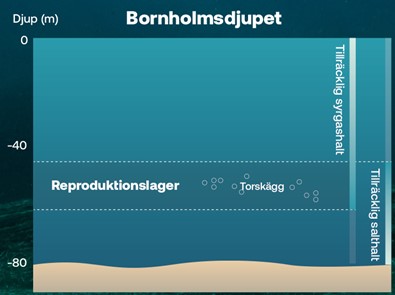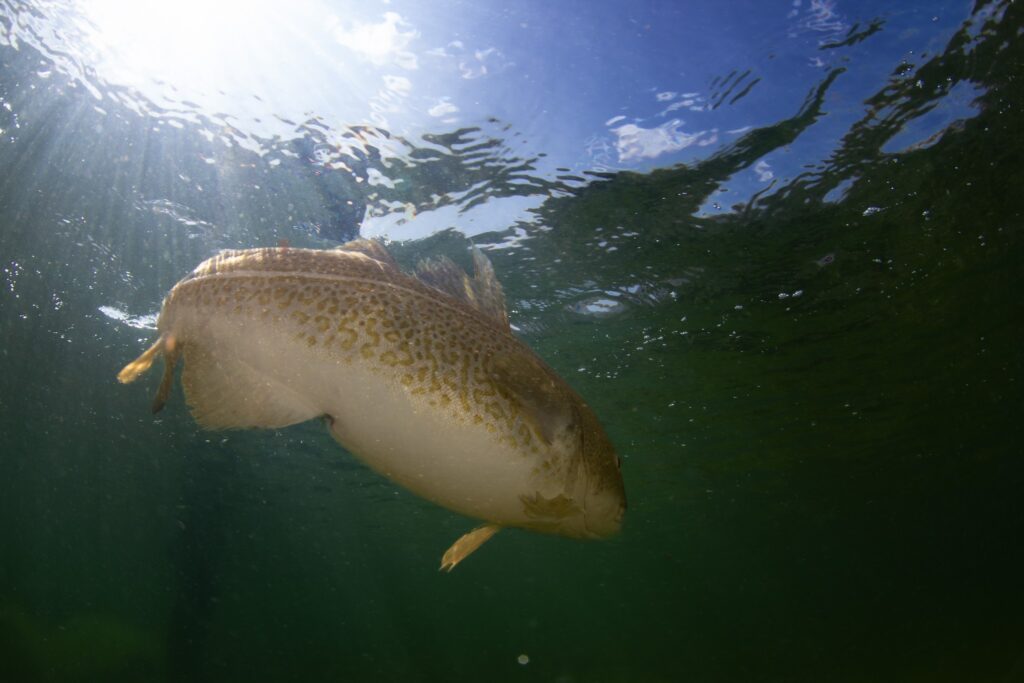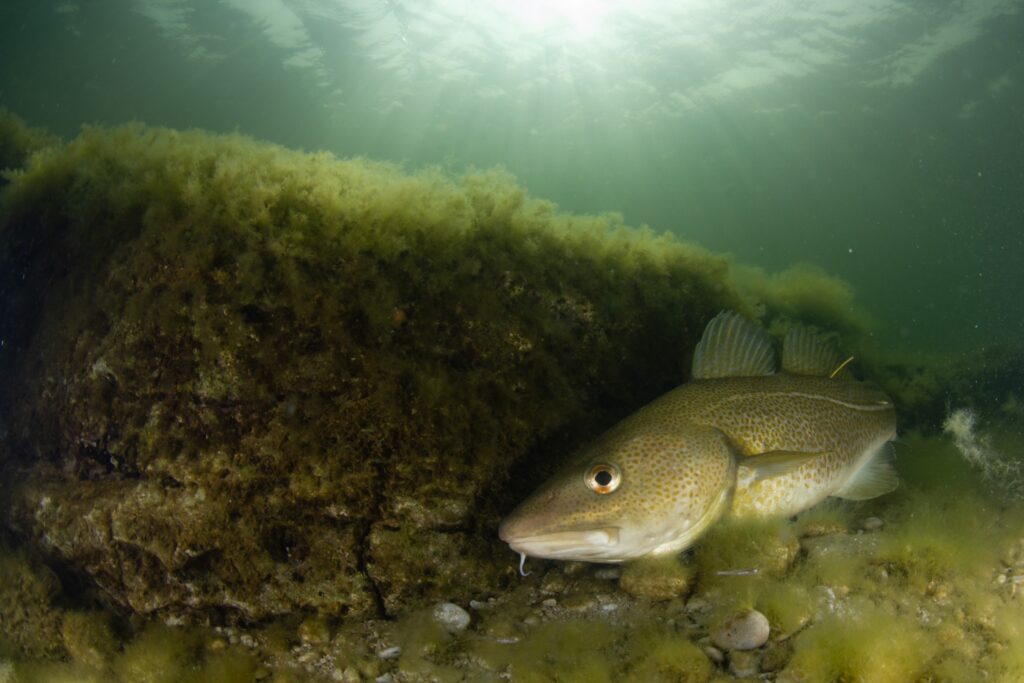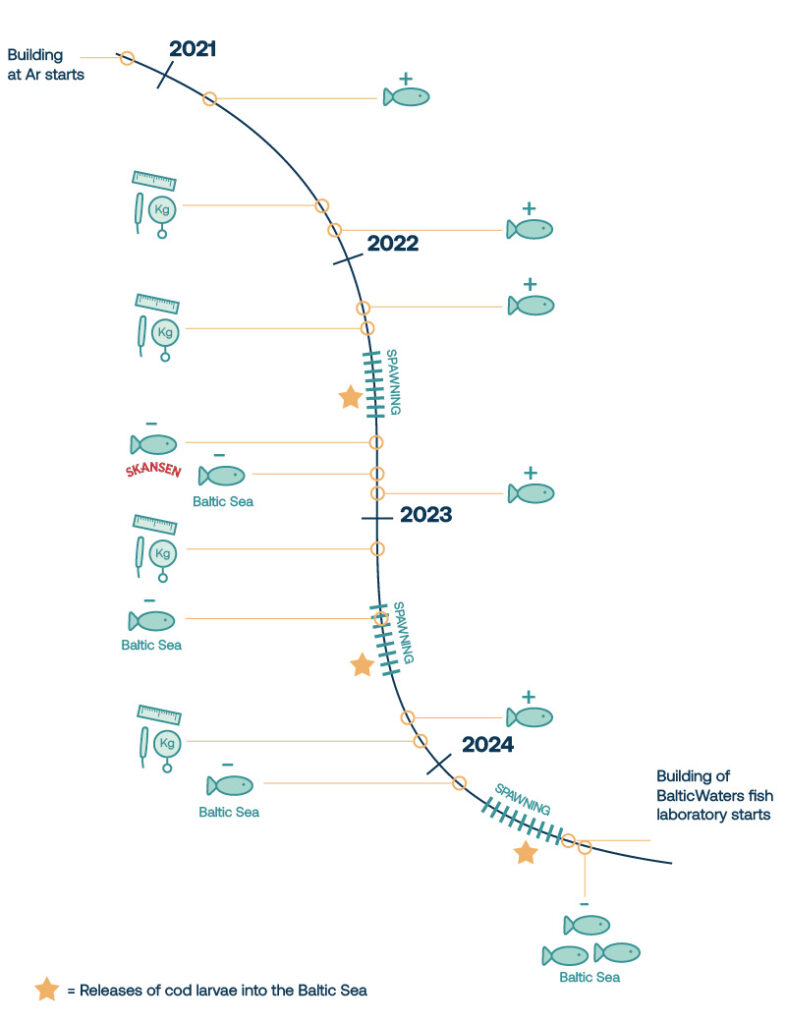Four years ago, the project ReCod – release of small cod in the Baltic Sea began at the small Ar research station on Gotland – an exciting, and often challenging, journey into unexplored territory. Now we are standing here on the rocky shore of Gotland to release the last cod that have lived and spawned at the station. In total, almost 1,000 cod have lived at the station, and together they have produced almost 2,500,000 cod larvae that have been released into the Baltic Sea. With the last cod returning to the inland sea, the project is on hold pending the completion of the new fish research laboratory – a place where ReCod will be scaled up to something even bigger.
Why release cod larvae?
The aim of ReCod has not been to find a solution that will save the Baltic cod stock, but to see if it is possible to help the cod past the vulnerable egg stage and thus eventually increase the number of cod in the Baltic Sea. The ability of cod to reproduce has deteriorated and today there is only one place in the Baltic Sea with the oxygen and salinity levels required for cod to succeed in their reproduction – the Bornholm Deep. In the first stage of ReCod, the goal has therefore been to release 4–6-day old cod larvae at a number of selected sites in the Baltic Sea to see if they survive and establish themselves. Should the larvae survive and grow into small fry, the project could serve as a template for restocking of the endangered eastern Baltic cod. Because restocking can be a way to strengthen the stock, although many more measures are needed to ensure recovery of the Baltic cod.
Baltic cod is clearly fighting an uphill battle, but the more knowledge we gain, the more effective measures we can put in place to reverse the negative trend. That is why ReCod will be scaled up.
‘In the first stage of the project, we have chosen to release larvae that are at an early stage of their life. In the wild, the mortality rate of these larvae is very high, close to 98%. But a large female cod can lay millions of eggs in a season, so we hope that if we can help the larvae get past the first vulnerable stages they will do well in the wild! And that’s what we will be working on in step two of the project – rearing the larvae to about 30 days, and then to small fish about 1 to 2 cm in size‘ says Konrad Stralka, CEO of BalticWaters.

Cod reproduction is limited by both salinity and oxygen levels. The picture shows the so-called reproductive layer (reproduktionslager) where salt and oxygen levels are within a range that allow the eggs to float and survive. Below the lower limit of the reproductive layer, oxygen levels are too low and above the reproductive layer, salinity is too low. Source: Vallin L., Nissling A., (2000) “Maternal effects on egg size and egg buoyancy of Baltic cod, Gadus morhua Implications for stock structure effects recruitment”, Fisheries Research 49 21-3
New challenges
Hatching cod larvae and releasing them into the sea when they are only 4-6 days old means that the larvae have not started feeding yet. Instead, they live on their yolk sac during their life at the research station, a nutritional sac on their stomachs that the larvae are born with.
‘Feeding larvae and fry that are born in captivity, but then released into the wild is tricky. We don’t want to affect their hunting behavior, but at the same time we need to become experts in cultivating plankton and other food. We have very good contacts in, for example, Norway and Denmark which have long experience of breeding and keeping cod through all life stages, which has given us very valuable knowledge,‘ says Johanna Fröjd, project manager for ReCod.
However, the continuation of ReCod will have to wait until the building of the new fish research laboratory is completed, which is planned to be ready in the end of 2025. The new laboratory is a prerequisite for scaling up the project, as it requires more space and technology than is currently available at Ar.
The parent fish on Ar, i.e. the adult cod that have lived and spawned at the research station, have finished spawning for this season and are now being released back into the Baltic Sea.
‘With the move from Ar, the parent fish within the project will return to life in the Baltic Sea. Once we move into the new laboratory, new fish will be brought in to ensure genetic variation in all the larvae and juveniles hatched in the project,’ says Johanna.
But she admits that there are mixed feelings about releasing the parent fish.
‘It obviously feels good that the fish can return to their natural environment and hopefully they will also have offspring in the wild. However, life in the Baltic Sea is harder than it has been here at the station. In the wild, for example, the cod need to find their own food, which can be difficult as herring and sprat stocks in the Baltic Sea have declined due to overfishing, says Johanna and continues:
‘The cod we release are healthy and have grown a lot since they moved into the research station so they are in good condition for life in the wild, but on a personal level I will miss them.
Although this is one of many cod releases, it is always exciting. One by one, the fish are released close by the shore. Some peek out of the bucket and swim off in confusion, while others flick their tails and are gone in seconds.

Photo: Madeleine Kullenbo, BalticWaters



Photos: Madeleine Kullenbo, BalticWaters
ReCod so far
But what about the first part of ReCod, have we succeeded? Do the released cod survive and establish themselves?
‘That is the big question. In test fishing in Tvären, about a year after the first releases, we have caught cod that we hope come from our releases,’ says Johanna. She continues:
‘There are several studies and research that have come out of ReCod that will be published soon. We have learnt a lot about cod and their different life stages. I hope, of course, that the cod we have caught during the test fishing are small cod larvae from ReCod that have grown into juveniles, especially as there has been no cod in Tvären for over 30 years and the salinity is too low in the area for the fish to reproduce locally. But whether it’s our fish or not, we have new experience and knowledge about cod that cannot be obtained in any other way than by carrying out this type of project.
Update: Was it our cod in Tvären?
In early September, the results of the DNA analysis came back. Unfortunately, it was not possible to draw any conclusions. On the one hand, about 25% of the DNA of the parent fish was missing (i.e. the adult cod that lived and spawned at the station so that small cod larvae hatched), and on the other hand, some samples had gone bad. Out of 23 samples, 14 could be analyzed and the results show that there is no relationship between the cod found in Tvären and the parent fish from ReCod. However, the sample is so small and uncertain that it is not possible to draw any conclusions about the success or failure of the releases.
The test fishing will continue, both this autumn and in spring 2025. As the methods developed in the project and the procedures in the laboratory and at the releases have improved over the years, the chances of finding more material to analyze are also improving. With a little luck, we will find some cod in Tvären that have parents who lived at the Ar research station.

Illustration of the ReCod project so far. At the end of 2020, the research station at Ar was rebuilt to hold adult cod for spawning and hatching cod larvae. In early 2021, the first cod from the Baltic Sea moved into the station. During the first year of operation (2021) no releases were done, but it was an important learning year for keeping cod and getting them to spawn naturally at the station. Once or twice a year, cod have been fished from the eastern stock and brought into the station to ensure that all cod larvae that hatch have a genetic variation, it also means that cod that have lived at the station for some time are released back into the Baltic Sea, while some have moved permanently to the Baltic Sea Science Centre at Skansen. All cod brought to the station are weighed, measured and tagged. Cod spawning takes place between May and August each year, and during that period a number of releases have been done in the Baltic Sea, and also one in the Gävle Bay. In August 2024, all parental fish were released back into the Baltic Sea and Ar is starting to be prepared for dismantling. At the same time, construction of the BalticWater fish research laboratory has started. Illustration: Madeleine Kullenbo, BalticWaters
Research within the framework of ReCod
Read more about research and studies conducted within the framwork of ReCod here.
Why are Baltic cod not recovering? We have investigated this in a feeding experiment, read a summary of the experiment here.

About ReCod
Since 2021 the project has been carried out at the research station Ar on Gotland – in the middle of the Baltic Sea. The goal of ReCod is to conduct experiments with the release of 4–6-day-old cod larvae at several locations along the east coast to investigate whether the larvae survive and successfully establish themselves. If the experiments are successful, there is the possibility of reintroducing cod in the Baltic Sea at more locations, thereby increasing the chances of preserving and protecting the unique eastern stock.
ReCod is implemented and financed by BalticWaters and Uppsala University. In addition, a number of partners are contributing to the project in various ways: Leader Gute, Region Gotland, the Swedish University of Agricultural Sciences and the Ulla and Curt Nicolin Foundation. In total, just over SEK 50 million is being invested in the project.
From 2025, the ReCod project will be conducted at BalticWaters fish research laboratory, which is being built outside Nyköping.

